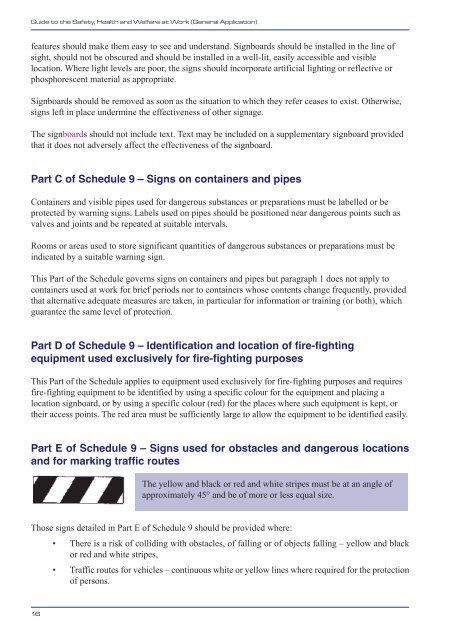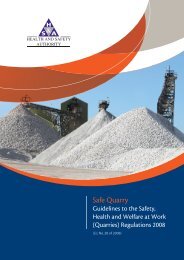Safety Signs at a Place of Work 2010 - Health and Safety Authority
Safety Signs at a Place of Work 2010 - Health and Safety Authority
Safety Signs at a Place of Work 2010 - Health and Safety Authority
Create successful ePaper yourself
Turn your PDF publications into a flip-book with our unique Google optimized e-Paper software.
Guide to the <strong>Safety</strong>, <strong>Health</strong> <strong>and</strong> Welfare <strong>at</strong> <strong>Work</strong> (General Applic<strong>at</strong>ion)<br />
fe<strong>at</strong>ures should make them easy to see <strong>and</strong> underst<strong>and</strong>. Signboards should be installed in the line <strong>of</strong><br />
sight, should not be obscured <strong>and</strong> should be installed in a well-lit, easily accessible <strong>and</strong> visible<br />
loc<strong>at</strong>ion. Where light levels are poor, the signs should incorpor<strong>at</strong>e artificial lighting or reflective or<br />
phosphorescent m<strong>at</strong>erial as appropri<strong>at</strong>e.<br />
Signboards should be removed as soon as the situ<strong>at</strong>ion to which they refer ceases to exist. Otherwise,<br />
signs left in place undermine the effectiveness <strong>of</strong> other signage.<br />
The signboards should not include text. Text may be included on a supplementary signboard provided<br />
th<strong>at</strong> it does not adversely affect the effectiveness <strong>of</strong> the signboard.<br />
Part C <strong>of</strong> Schedule 9 – <strong>Signs</strong> on containers <strong>and</strong> pipes<br />
Containers <strong>and</strong> visible pipes used for dangerous substances or prepar<strong>at</strong>ions must be labelled or be<br />
protected by warning signs. Labels used on pipes should be positioned near dangerous points such as<br />
valves <strong>and</strong> joints <strong>and</strong> be repe<strong>at</strong>ed <strong>at</strong> suitable intervals.<br />
Rooms or areas used to store significant quantities <strong>of</strong> dangerous substances or prepar<strong>at</strong>ions must be<br />
indic<strong>at</strong>ed by a suitable warning sign.<br />
This Part <strong>of</strong> the Schedule governs signs on containers <strong>and</strong> pipes but paragraph 1 does not apply to<br />
containers used <strong>at</strong> work for brief periods nor to containers whose contents change frequently, provided<br />
th<strong>at</strong> altern<strong>at</strong>ive adequ<strong>at</strong>e measures are taken, in particular for inform<strong>at</strong>ion or training (or both), which<br />
guarantee the same level <strong>of</strong> protection.<br />
Part D <strong>of</strong> Schedule 9 – Identific<strong>at</strong>ion <strong>and</strong> loc<strong>at</strong>ion <strong>of</strong> fire-fighting<br />
equipment used exclusively for fire-fighting purposes<br />
This Part <strong>of</strong> the Schedule applies to equipment used exclusively for fire-fighting purposes <strong>and</strong> requires<br />
fire-fighting equipment to be identified by using a specific colour for the equipment <strong>and</strong> placing a<br />
loc<strong>at</strong>ion signboard, or by using a specific colour (red) for the places where such equipment is kept, or<br />
their access points. The red area must be sufficiently large to allow the equipment to be identified easily.<br />
Part E <strong>of</strong> Schedule 9 – <strong>Signs</strong> used for obstacles <strong>and</strong> dangerous loc<strong>at</strong>ions<br />
<strong>and</strong> for marking traffic routes<br />
The yellow <strong>and</strong> black or red <strong>and</strong> white stripes must be <strong>at</strong> an angle <strong>of</strong><br />
approxim<strong>at</strong>ely 45° <strong>and</strong> be <strong>of</strong> more or less equal size.<br />
Those signs detailed in Part E <strong>of</strong> Schedule 9 should be provided where:<br />
• There is a risk <strong>of</strong> colliding with obstacles, <strong>of</strong> falling or <strong>of</strong> objects falling – yellow <strong>and</strong> black<br />
or red <strong>and</strong> white stripes,<br />
• Traffic routes for vehicles – continuous white or yellow lines where required for the protection<br />
<strong>of</strong> persons.<br />
16

















